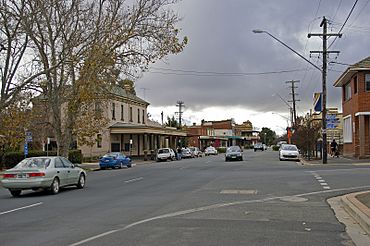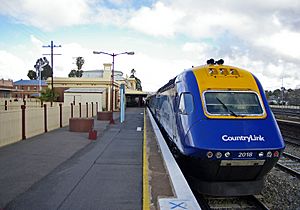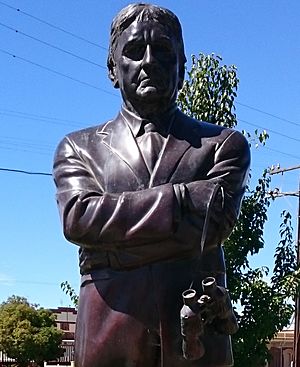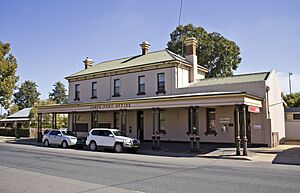Junee facts for kids
Quick facts for kids JuneeNew South Wales |
|||||||||
|---|---|---|---|---|---|---|---|---|---|

Lorne Street
|
|||||||||
| Established | Late 1870s | ||||||||
| Postcode(s) | 2663 | ||||||||
| Elevation | 280 m (919 ft) | ||||||||
| Time zone | AEST (UTC+10) | ||||||||
| • Summer (DST) | AEDT (UTC+11) | ||||||||
| Location |
|
||||||||
| LGA(s) | Junee Shire | ||||||||
| County | Clarendon | ||||||||
| State electorate(s) | Cootamundra | ||||||||
| Federal Division(s) | Riverina | ||||||||
|
|||||||||
Junee (pronounced "joo-NEE") is a medium-sized town in the Riverina region of New South Wales, Australia. The town's success comes from a mix of farming, train transport, small businesses, and government services, especially correctional services. In 2021, about 4,882 people lived in Junee.
Contents
What Does Junee Mean?
There are two main ideas about where the name Junee comes from.
- One idea is that it comes from an Aboriginal word meaning "speak to me".
- Another idea is that it comes from an Aboriginal word "Choo-nee", which means "frog".
Junee's Past: A Look Back
Early Days and First Settlers
The Wiradjuri people were the first people to live in the Junee area. They are the traditional owners of this land.
Later, in 1845, a man named Leopold de Salis set up a large sheep and cattle farm, called a 'pastoral run', in the area. He was one of the first European settlers to open up the Riverina region for farming. After him, other people took over the farm. In 1857, Thomas Hammond and Richard Gwynne bought the farm license. Hammond lived there until he passed away in 1899.
Village Life and Gold Rush
A post office opened in Junee in 1862. A small village was officially named 'Junee' in 1863. This village was on the main road used to transport wool to Sydney. In the same year, the famous bushranger Ben Hall and his gang raided the village.
In 1866, only twelve people lived in Junee. But then, gold was found in the 1860s! This started a "gold rush" as many people came looking for gold. Gold was mined in places like Junee Reefs (to the north) and Wantiool and Eurongilly (to the east). Mining continued on and off until after World War 1.

The Arrival of the Railway
In 1878, the main railway line between Sydney and Melbourne was built. It passed about 8 kilometres east of the original Junee village. Because of the railway, the old Junee Post Office was renamed Old Junee in 1885. A new post office opened at the railway station on 6 July 1878. It was first called Junee Railway Station Post Office, then Junee Junction in 1881, and finally just Junee in 1893.
Trains, Roads, and the Economy
Connecting Junee by Rail and Road
The main railway line connecting Sydney and Melbourne goes right through Junee. The Olympic Highway also passes through the town. This highway was named after the route of the 1956 Summer Olympics Torch Relay.
The railway arriving in 1878 was a huge boost for Junee. It made it much easier and cheaper for local farmers to send their goods to markets in Sydney. In 1952, the biggest wheat storage facility in the Southern Hemisphere was built in Junee. It could handle wheat arriving by both train and road.
Rail's Role Today
Train transport is still very important for Junee's economy. A company called Regional Rail Logistics runs a freight service that sends goods in containers from Junee to Sydney. Other freight trains also pass through the town, carrying goods across different states.
Ray Warren Statue
On 6 August 2011, a bronze statue of famous rugby league commentator Ray Warren was put up in Dobbyn Park.
Junee's Weather
Junee has a rather dry humid subtropical climate (Köppen Cfa). This means it has long, hot, and dry summers. Winters are cool and often cloudy, with low rainfall all year.
The hottest temperature ever recorded in Junee was 46.1°C on 31 January 1968. The coldest temperature was -5.0°C, recorded on 1 July 1971 and 6 August 1974. On average, Junee gets about 530.6 mm of rain each year. Sometimes, though rarely, snow can fall. The last time this happened was in August 2019.
| Climate data for Junee Treatment Works (1907–1975, rainfall 1891–2022); 280 metres or 919 feet AMSL; 34.85° S, 147.57° E | |||||||||||||
|---|---|---|---|---|---|---|---|---|---|---|---|---|---|
| Month | Jan | Feb | Mar | Apr | May | Jun | Jul | Aug | Sep | Oct | Nov | Dec | Year |
| Record high °C (°F) | 46.1 (115.0) |
44.4 (111.9) |
40.6 (105.1) |
32.8 (91.0) |
25.6 (78.1) |
21.6 (70.9) |
23.0 (73.4) |
26.1 (79.0) |
33.3 (91.9) |
35.0 (95.0) |
38.3 (100.9) |
40.6 (105.1) |
46.1 (115.0) |
| Mean daily maximum °C (°F) | 32.4 (90.3) |
31.6 (88.9) |
28.4 (83.1) |
22.8 (73.0) |
17.9 (64.2) |
13.9 (57.0) |
13.2 (55.8) |
15.1 (59.2) |
18.9 (66.0) |
22.7 (72.9) |
27.0 (80.6) |
30.8 (87.4) |
22.9 (73.2) |
| Mean daily minimum °C (°F) | 15.5 (59.9) |
15.6 (60.1) |
12.9 (55.2) |
8.6 (47.5) |
5.5 (41.9) |
3.3 (37.9) |
2.3 (36.1) |
3.2 (37.8) |
5.0 (41.0) |
7.4 (45.3) |
10.2 (50.4) |
13.5 (56.3) |
8.6 (47.4) |
| Record low °C (°F) | 5.6 (42.1) |
7.0 (44.6) |
3.9 (39.0) |
0.6 (33.1) |
−2.8 (27.0) |
−4.0 (24.8) |
−5.0 (23.0) |
−5.0 (23.0) |
−3.3 (26.1) |
−2.8 (27.0) |
1.7 (35.1) |
3.8 (38.8) |
−5.0 (23.0) |
| Average precipitation mm (inches) | 40.8 (1.61) |
37.2 (1.46) |
40.9 (1.61) |
40.6 (1.60) |
42.9 (1.69) |
49.8 (1.96) |
47.0 (1.85) |
46.8 (1.84) |
44.2 (1.74) |
50.9 (2.00) |
44.7 (1.76) |
41.4 (1.63) |
530.6 (20.89) |
| Average precipitation days (≥ 0.2 mm) | 4.9 | 4.6 | 4.5 | 5.5 | 7.8 | 9.5 | 11.2 | 11.0 | 8.8 | 8.2 | 6.3 | 5.4 | 87.7 |
| Source: Bureau of Meteorology (1891–2022) | |||||||||||||
Special Places in Junee
Junee has several places that are important for their history and are protected. These include:
- 119 Lorne Street: Junee Post Office
- Main Southern railway: Junee railway station
- The Broadway: Athenium Theatre
Who Lives in Junee?
According to the 2021 census, there were 4,882 people living in Junee.
- About 9.4% of the people were Aboriginal and Torres Strait Islander people.
- Most people (81.5%) were born in Australia. Other common birthplaces included China (1.9%), England (1.3%), and New Zealand (1.0%).
- About 70.9% of people spoke only English at home. Other languages spoken included Mandarin (2.1%) and Fijian (0.7%).
- Many people in Junee identify with a religion. About 25.2% are Catholic, 17.4% are Anglican, and 2.6% are Presbyterian. About 23.8% said they had no religion.
| Historical population | ||
|---|---|---|
| Year | Pop. | ±% |
| 1921 | 3,560 | — |
| 1933 | 4,213 | +18.3% |
| 1947 | 4,010 | −4.8% |
| 1954 | 4,064 | +1.3% |
| 1961 | 3,980 | −2.1% |
| 1966 | 3,906 | −1.9% |
| 1971 | 3,772 | −3.4% |
| 1976 | 4,005 | +6.2% |
| 1981 | 3,993 | −0.3% |
| 1986 | 3,720 | −6.8% |
| 1991 | 3,673 | −1.3% |
| 1996 | 3,681 | +0.2% |
| 2001 | 3,589 | −2.5% |
| 2006 | 3,744 | +4.3% |
| 2011 | 4,400 | +17.5% |
| 2016 | 4,762 | +8.2% |
| 2021 | 4,882 | +2.5% |
| Source: Australian Bureau of Statistics data. | ||
Sports in Junee
The most popular sport in Junee is rugby league. The town's team is called the Junee Diesels. They play in the Group 9 Rugby League competition and have won two championships. A famous player from this club is Laurie Daley, who became captain for both the New South Wales and Australian teams.
In the past, Junee also had teams for Australian rules football (the Bulldogs) and rugby union (the Rams), but these teams no longer exist.
Famous People from Junee
Here are some notable people who have connections to Junee:
- Laurie Daley: A famous rugby league player and captain for New South Wales and Australia.
- Bernie Fraser: A former head of the Reserve Bank of Australia.
- Bill Heffernan: A former Senator for New South Wales.
- Lawrence Legend: A motorcycle stuntman.
- Ray Warren: A well-known sports commentator.
How Junee Stays Connected
Junee has its own ways of sharing news and information:
- The Junee Independent newspaper.
- A Radio 1RPH transmitter (99.5FM) for radio broadcasts.




